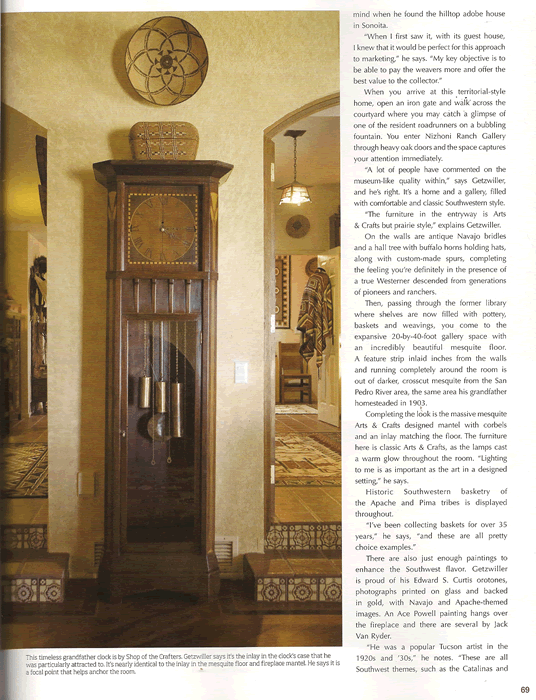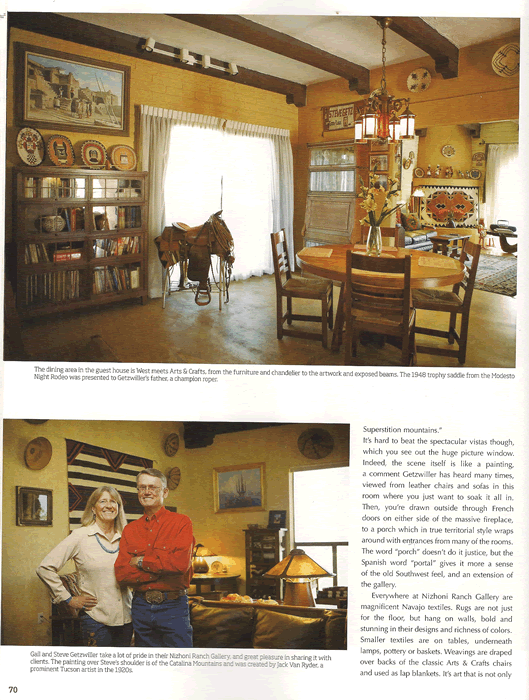Press: Western Art Collector - Nizhoni Ranch Gallery - A Beautiful Place - July 2010






A BEAUTIFUL PLACE
Steve Getzwiller's Nizhoni Ranch Gallery showcases Southwest classicsJuly 2010: Who could argue with the joy of living surrounded by beautiful things? Think about the satisfaction of filling a home with art you are passionate about, collecting each piece with care. While it’s a reality for some and a dream for others, it’s become a way of life, and a living for a man who shares his knowledge and enthusiasm with others from all over the world.
Surrounded by mountains in the rolling grasslands of Sonoita, Arizona and about an hour southeast of Tucson, Steve Getzwiller welcomes you to his Nizhoni Ranch Gallery. When it comes to Navajo textiles, Getzwiller is recognized as one of the premier collectors and dealers in the country. For nearly 40 years, this native Arizonan has been at the forefront of contemporary Navajo weaving. He’s traveled from one end of the Navajo nation to the other, working with and encouraging scores of weavers to advance their art, taking it “to the next level,” as he calls it. That includes bringing back traditional dyes which have not been used for well over a century.
With Getzwiller’s support, these Native American artists use Churro wool, silk and alpaca fibers, with combs and nimble fingers instead of a palette and brush, to create dazzling works of art. Not only does he collect and sell but also demonstrates how wonderful it is to live with Navajo textiles. His home and gallery is direct marketing in its purest form. “I’ve elected to market from a place with one stop sign and very successfully,” he says with a smile. “It makes a wonderful showplace,” he says, gesturing around the spacious and magnificent home. “The objective is to show people how they can live with fine Native American artwork within the context of their own homes.”
“We’ll start in the entryway, work our way through the gallery and look at all the different options to be considered. We’ll take weavings out onto the porch to view them in natural light, where this exclusive palette of color really becomes apparent; here someone can visualize how it would look hanging in their own space, and they love it!”
While he spent his first 30 years working with some of the finest galleries, and still does with a few, his business model now follows that of Lorenzo Hubbell.
More than a hundred years ago, Hubbell’s trading post in Ganado was a destination for the Easterners traveling through “Indian Country” giving them not just a place to stay, but an experience, for which he would not accept payment. Getzwiller says Hubbell would tell his guests instead to “come into my rug room, and I will knock your eye out.” That quote was foremost in Getzwiller’s mind when he found the hilltop adobe house in Sonoita. “When I first saw it, with its guest house, I knew that it would be perfect for this approach to marketing.
My key objective is to be able to pay the weavers more and offer the best value to the collector.” When you arrive at this territorial-style home, open an iron gate and walk across the courtyard where you may catch a glimpse of one of the resident roadrunners on a bubbling fountain. You enter Nizhoni Ranch Gallery through heavy oak doors and the space captures your attention immediately. “A lot of people have commented on the museum-like quality within,” says Getzwiller, and he’s right. It’s a home and a gallery, filled with comfortable and classic southwestern style.
“The furniture in the entryway is Arts & Crafts, but prairie style,” explains Getzwiller. On the walls are antique Navajo bridles and a hall tree with buffalo horns holding hats, along with custom-made spurs, completing the feeling you’re definitely in the presence of a true Westerner, descended from generations of pioneers and ranchers. Then, passing through the former library where shelves are now filled now with pottery, baskets, and weavings, you come to the expansive 20 x 40 foot gallery space, with an incredibly beautiful mesquite floor. A feature strip inlaid inches from the walls and running completely around the room is out of darker, crosscut mesquite from the San Pedro River area, the same area his grandfather homesteaded in 1903. Completing the look is the massive mesquite Arts & Crafts designed mantel with corbels and an inlay matching the floor. The furniture here is classic Arts & Crafts, as the lamps cast a warm glow throughout the room. “Lighting to me is as important as the art in a designed setting,” he says.
Historic southwestern basketry of the Apache and Pima tribes are displayed throughout.
“I’ve been collecting baskets for over 35 years,” he says, “and these are all pretty choice There are also just enough paintings to enhance the southwest flavor. Getzwiller is proud of his Edward S. Curtis orotones, photographs printed on glass and backed in gold, with Navajo and Apache-themed images. An Ace Powell painting hangs over the fireplace, and there are several by Jack Van Ryder. “He was a popular Tucson artist in the 1920’s and 30’s. These are all southwest themes, such as the Catalinas and Superstition mountains.” It’s hard to beat the spectacular vistas though, which you see out the huge picture window.
Indeed, the scene itself is like a painting, a comment Getzwiller has heard many times, viewed from leather chairs and sofas in this room where you just want to soak it all in. Then, you’re drawn outside through French doors on either side of the massive fireplace, to a porch which in true territorial style wraps around with entrances from many of the rooms. The word “porch” doesn’t do it justice, but the Spanish word “portal” gives it more a sense of the old Southwest feel, and an extension of the gallery. Everywhere at the Nizhoni Ranch Gallery are magnificent Navajo textiles. Rugs are not
just for the floor, but hang on walls, bold and stunning in their designs and richness of colors.
Smaller textiles are on tables, underneath lamps, pottery or baskets. Weavings are draped over backs of the classic Arts & Crafts chairs and used as lap blankets. It’s art which is not only tastefully arranged, but constantly changed as pieces are sold or collected. Each visit is different from the last, with new things to see and appreciate. The dining room features an Arts & Crafts Handell chandelier, while antique saddle blankets grace the backs of chairs surrounding the 13-foot table. Glass front cabinets filled with antique and contemporary Navajo weavings are throughout the gallery, with one in the dining room holding more recent acquisitions.The long table serves a dual purpose for Getzwiller showing clients photos of works still on the loom, the talented artists who make them, or simply looking up the history of a piece.
This room is home to the registries documenting the more than 1,200 weavings from the “Navajo Churro Collection” dating 1995 to present. One set of albums documents the first piece to the most recent. Another reflects each artist from their first to their most current creation. “The objective is when I am no longer able to pursue this, that this documentation is available to museums which will house this material.”
With antique blankets, Getzwiller has a tremendous respect and admiration for those unknown weavers so long ago. “Even though I have dealt in antique weavings for many years, it’s always bothered me that the women who created these beautiful works of art are unknown. Because I’ve handled so many of the older pieces, there are instances when I can actually identify a weaver’s hand by their style and technique. But, they’re anonymous because in those days, records were not kept.” He doesn’t want the same thing to happen to the weavers he’s come to know. “It’s important to me that the women I work with be recognized, so people will know who they are a hundred years from now. Weavings from the Navajo Churro Collection are already earmarked for museum collections, and have been referred to as the classics of the future.”
“Our gallery and home is a destination for collectors. I am able to give quality time to each person that visits the gallery. We have clients not only from all around the country, but all over the world. I give them an experience they aren’t going to get anywhere else. The setting is wonderful, but it’s the sum total of it all that makes it so special.”
He admits Nizhoni Ranch Gallery is awkwardly named from a marketing perspective. But, it’s not until you experience the gallery in its scenic setting, or relaxing on the portal, listening to the wind, the quail and an occasional cactus wren, when you understand its true meaning. You see, Nizhoni is Navajo for “beautiful place”…and what a perfect name for this gallery that’s also a home.
Written by: Susan Sorg
Photographs by: Jeff Newton
